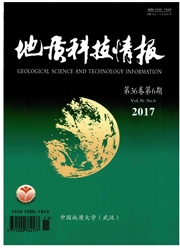

 中文摘要:
中文摘要:
九瑞地区中新生代发育多期次多层次不同类型的滑脱构造,在古生界-中生界沉积盖层中主要形成3种不同类型的滑脱断裂:近东西向的逆冲推覆型滑脱断裂、近东西向的正滑断裂及北东向的重力滑脱断裂。结合野外及显微构造特征,分别对其同构造成因的脉体进行了碳氧同位素和流体包裹体分析,结果表明:近东西向和北东向逆冲滑脱断裂带流体特征相似,主要来源于有限的大气降水参与的水岩相互作用所形成的两侧地层流体;正滑断裂中的断裂带流体主要为深部外来流体与大气降水的混合流体。3种类型滑脱断裂带的流体包裹体测温结果均呈现2个主要的温度峰值,断裂的活动主要在约3km和约4.5km 2个深度。滑脱断裂属浅层次低应力脆性断裂,构造变形和流体活动特征与志留系及滑脱构造演化密切相关。
 英文摘要:
英文摘要:
The Jiujiang-Ruichang area developed through multi-level,multi-period and multi-type gliding detachment faults.These three types of detachment fault developed in Paleozoic-Mesozoic sedimentary cover:east-west oriented overthrust detachment fault,east-west oriented extensional detachment fault and southwest-northeast oriented gravitational detachment fault.Based on the mesoscopic and microscopic investigation,we analyze the stable isotope and homogenization temperature of fluid inclusion of syntectonic veins.Both the EW and NE-SW overthrust detachment fault were similar in the fluid character.Limited atmospheric precipitation partaking the water-rock reaction formed the formation fluid.Fluid in the extensional detachment faults was mixed fluid of deep-external fluid and atmospheric precipitation.Homogenization temperature dates of fluid inclusion in three types detachment fault present two major peak value.Detachment faults mainly developed at 3km and 4.5km level.Detachment faults were shallow-level,lowstress and brittle faults.Structural deformation and fluid character were related to the Silurian system and evolution of detachment structure.
 同期刊论文项目
同期刊论文项目
 同项目期刊论文
同项目期刊论文
 期刊信息
期刊信息
